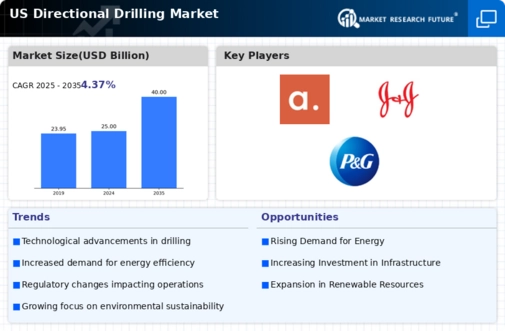Increased Demand for Energy Efficiency
The directional drilling market is experiencing heightened demand driven by the need for energy efficiency in drilling operations. As energy costs continue to rise, operators are seeking methods to optimize resource extraction while minimizing waste. This trend is particularly evident in the oil and gas sector, where directional drilling techniques allow for more precise targeting of reserves, thereby reducing the number of wells required. According to recent estimates, directional drilling can enhance recovery rates by up to 30%, making it a preferred choice for operators aiming to maximize output. The focus on energy efficiency is likely to propel investments in advanced drilling technologies, further stimulating growth in the directional drilling market.
Technological Integration and Automation
The integration of advanced technologies and automation in drilling operations is reshaping the directional drilling market. Innovations such as real-time data analytics, remote monitoring, and automated drilling systems are enhancing operational efficiency and safety. These technologies enable operators to make informed decisions quickly, reducing downtime and improving overall productivity. The market is witnessing a shift towards smart drilling solutions that leverage artificial intelligence and machine learning to optimize drilling parameters. As these technologies become more prevalent, they are likely to attract investments and drive growth in the directional drilling market, as operators seek to enhance their competitive edge.
Growing Investment in Renewable Energy Projects
The directional drilling market is also being influenced by the growing investment in renewable energy projects, particularly in geothermal energy extraction. As the US transitions towards more sustainable energy sources, the demand for directional drilling techniques in geothermal applications is expected to rise. Directional drilling allows for the efficient drilling of deep wells necessary for accessing geothermal resources, which can provide a stable and renewable energy supply. Recent reports suggest that investments in geothermal energy could reach billions of dollars in the coming years, further stimulating the directional drilling market. This shift towards renewable energy not only diversifies the market but also aligns with broader environmental goals.
Regulatory Support for Advanced Drilling Techniques
Regulatory frameworks in the US are increasingly supportive of advanced drilling techniques, including directional drilling. Government policies aimed at promoting efficient resource extraction and environmental protection are likely to bolster the directional drilling market. For instance, regulations that encourage the use of less invasive drilling methods can lead to a shift in industry practices. The US government has allocated substantial funding for research and development in drilling technologies, which may enhance the capabilities of directional drilling. This regulatory support not only fosters innovation but also ensures that operators can comply with environmental standards while optimizing their drilling operations.
Rising Exploration Activities in Unconventional Resources
The directional drilling market is significantly influenced by the rising exploration activities in unconventional resources such as shale gas and tight oil. As traditional reserves become depleted, operators are increasingly turning to these unconventional sources, which often require advanced drilling techniques for effective extraction. The US has vast reserves of shale formations, and the adoption of directional drilling is essential for accessing these resources efficiently. Recent data indicates that directional drilling is responsible for a substantial portion of the production from these unconventional plays, highlighting its critical role in the evolving energy landscape. This trend is expected to continue, driving further growth in the directional drilling market.














Leave a Comment